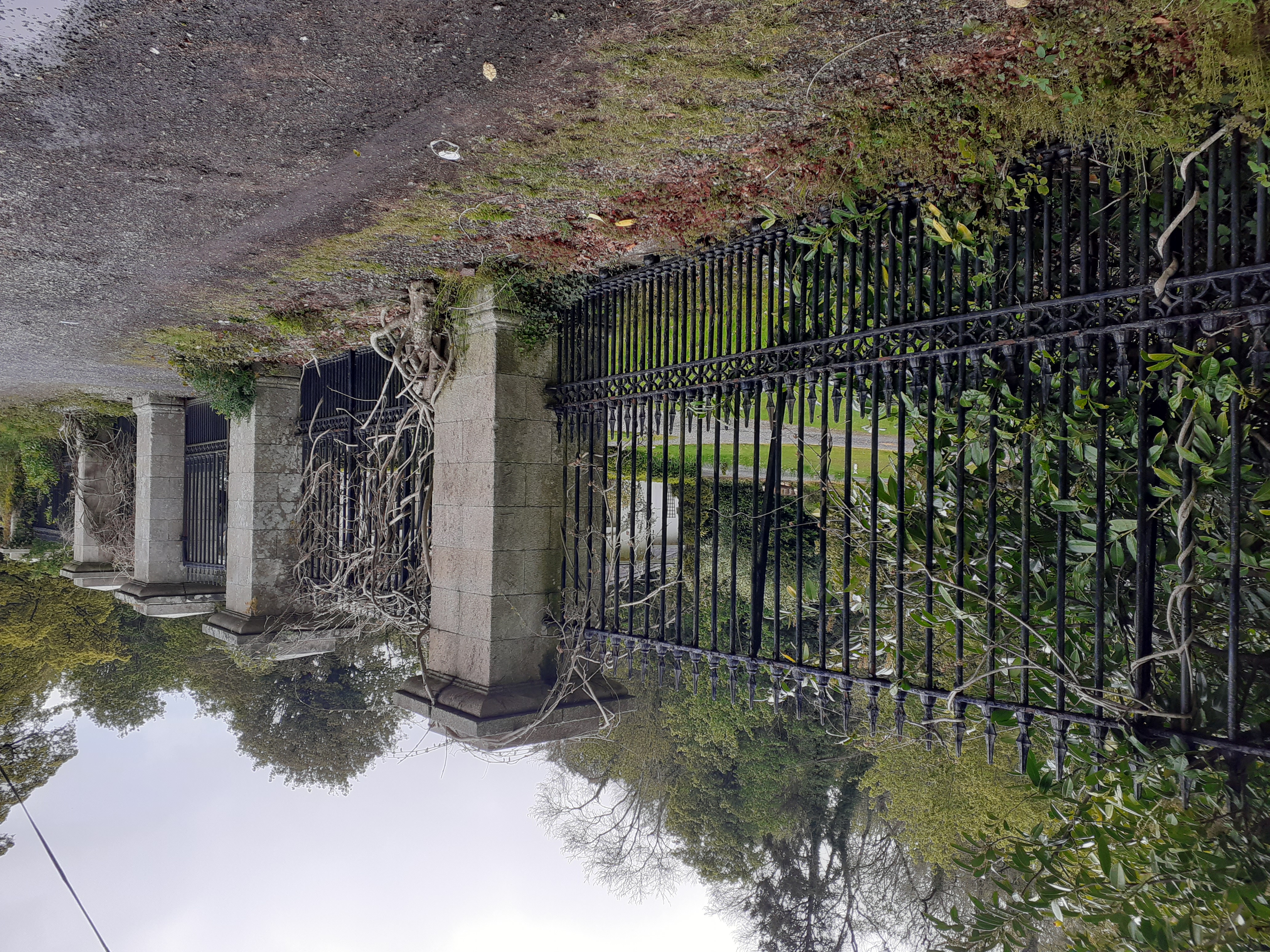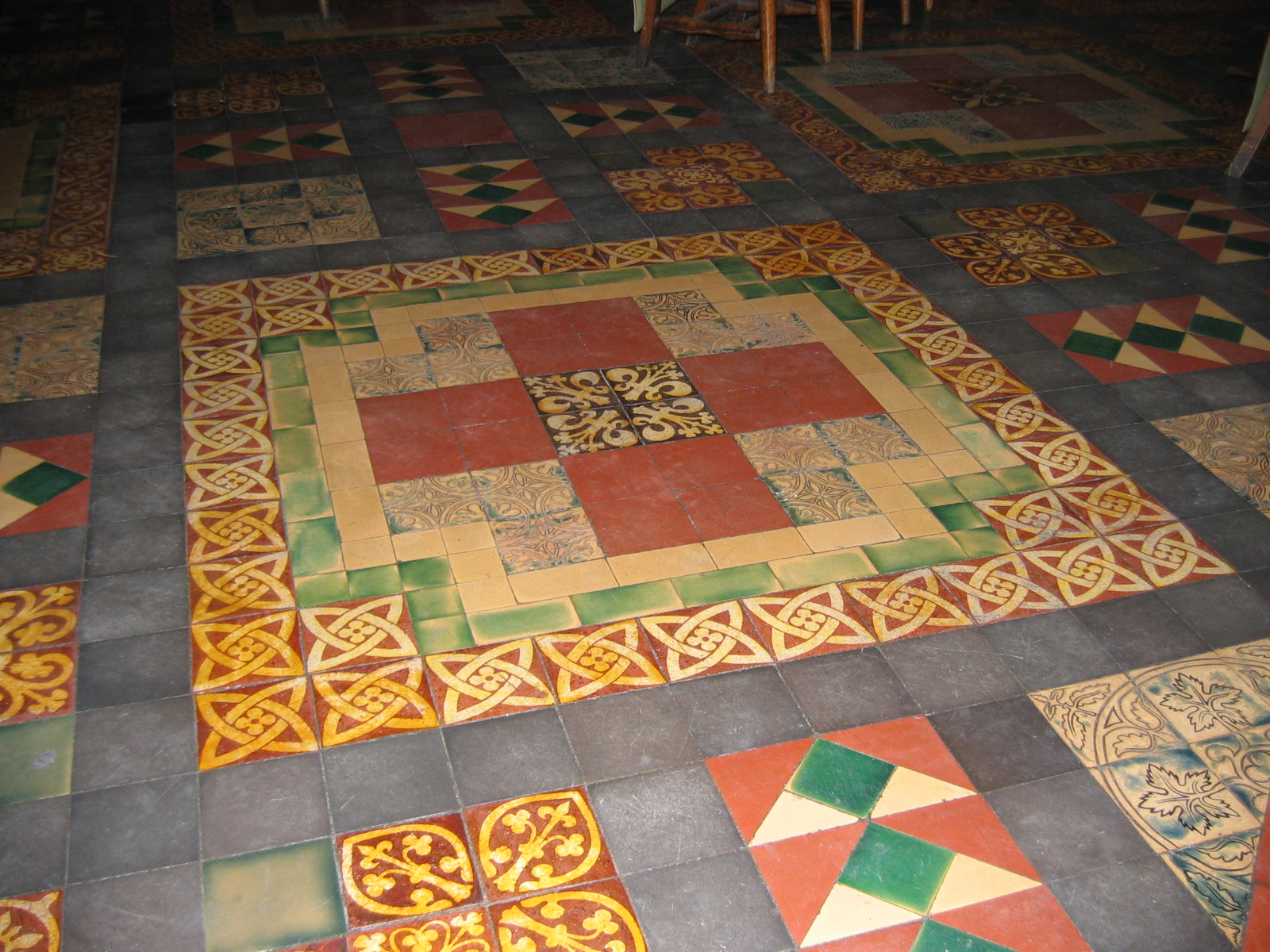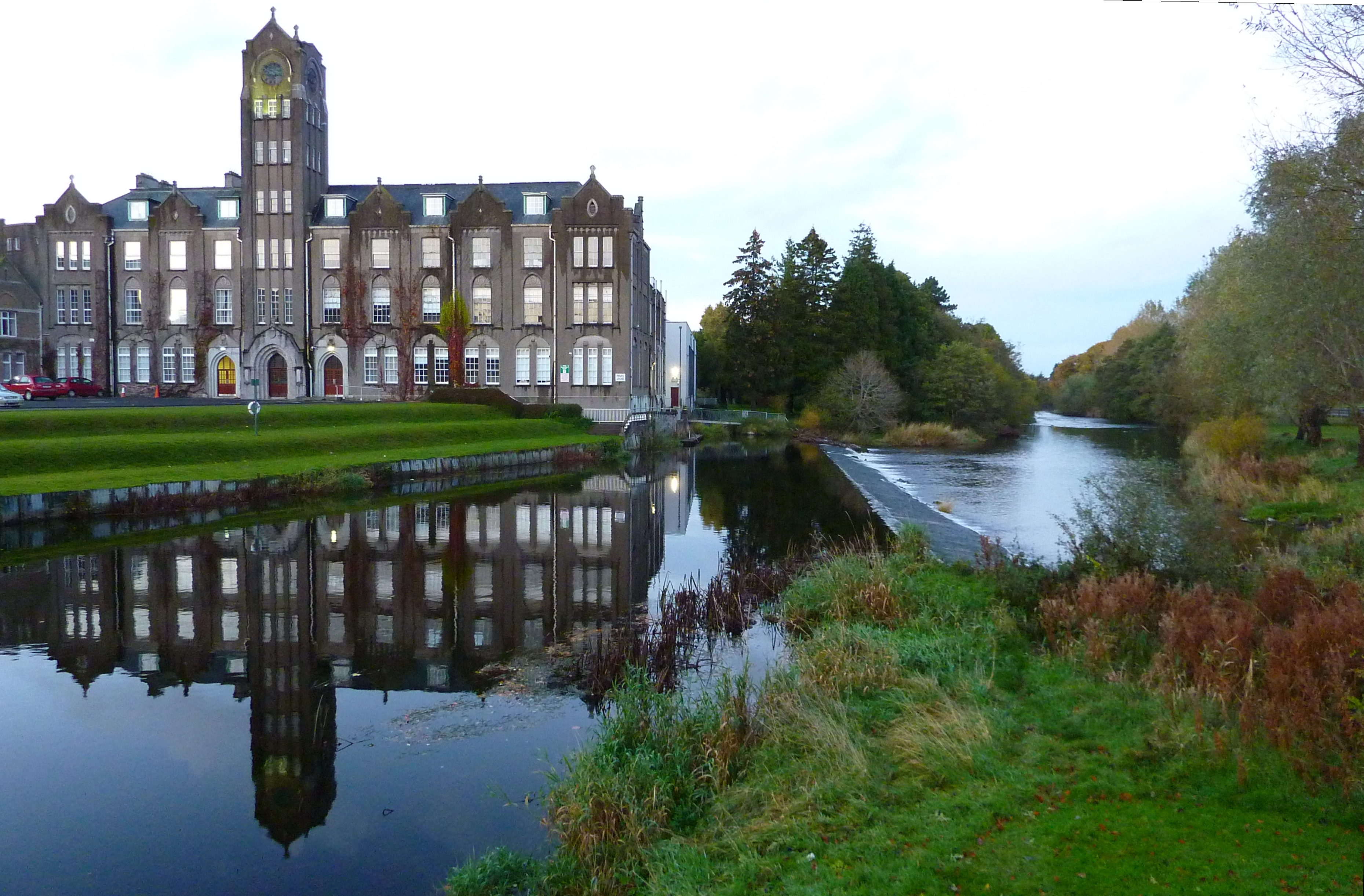|
Luttrellstown Castle
Luttrellstown Castle is a castellated house located in Clonsilla on the outskirts of Dublin, Ireland dating from the early 15th century (c. 1420). It has been owned variously by the eponymous and notorious Luttrell family, by the bookseller Luke White and his descendants Baron Annaly, by the Guinness family, the Primwest Group, and since 2006, by JP McManus, John Magnier and Aidan Brooks. The castle has hosted visits by Queen Victoria in 1844 and 1900, and its media profile was raised when Victoria Adams married David Beckham there on 4 July 1999. Demesne Luttrellstown Demesne originally comprised the entirety of the townland of "Woodlands" in the civil parish of Clonsilla. Today, Luttrellstown Castle Resort and its remaining demesne currently form a 5-star resort, with a golf course, country club and unique location just outside the city boundaries of Dublin. A stream rising near the townland of Pass-If-You-Can enters an aqueduct in the townland of Westmanstown and ... [...More Info...] [...Related Items...] OR: [Wikipedia] [Google] [Baidu] |
Gothic Architecture
Gothic architecture is an architectural style that was prevalent in Europe from the late 12th to the 16th century, during the High Middle Ages, High and Late Middle Ages, surviving into the 17th and 18th centuries in some areas. It evolved from Romanesque architecture and was succeeded by Renaissance architecture. It originated in the Île-de-France and Picardy regions of northern France. The style at the time was sometimes known as ''opus Francigenum'' (); the term ''Gothic'' was first applied contemptuously during the later Renaissance, by those ambitious to revive the Classical architecture, architecture of classical antiquity. The defining design element of Gothic architecture is the Pointed arch (architecture), pointed arch. The use of the pointed arch in turn led to the development of the pointed rib vault and flying buttresses, combined with elaborate tracery and stained glass windows. At the Abbey of Basilica of Saint-Denis, Saint-Denis, near Paris, the choir was rec ... [...More Info...] [...Related Items...] OR: [Wikipedia] [Google] [Baidu] |
Townland
A townland (; Ulster-Scots: ''toonlann'') is a traditional small land division used in Ireland and in the Western Isles of Scotland, typically covering . The townland system is of medieval Gaelic origin, predating the Norman invasion, and most have Irish-derived names. However, some townland names and boundaries come from Norman manors, plantation divisions, or later creations of the Ordnance Survey.Connolly, S. J., ''The Oxford Companion to Irish History, page 577. Oxford University Press, 2002. ''Maxwell, Ian, ''How to Trace Your Irish Ancestors'', page 16. howtobooks, 2009. Townlands cover the whole island of Ireland, and the total number of inhabited townlands in Ireland was 60,679 in 1911. The total number recognised by the Placenames Database of Ireland as of 2014 was 61,098, including uninhabited townlands. Etymology The term "townland" in English is derived from the Old English word ''tūn'', denoting an enclosure. The term describes the smallest unit of land di ... [...More Info...] [...Related Items...] OR: [Wikipedia] [Google] [Baidu] |
St Patrick's Cathedral, Dublin
Saint Patrick's Cathedral () in Dublin, Ireland is the national cathedral of the Church of Ireland. Christ Church Cathedral, Dublin, Christ Church Cathedral, also a Church of Ireland cathedral in Dublin, is designated as the local cathedral of the Diocese of Dublin and Glendalough. Background Unusually, St Patrick's is not the cathedra, seat of a bishop, as the Archbishop of Dublin (Church of Ireland), Archbishop of Dublin has his seat in Christchurch Cathedral, Dublin, Christ Church Cathedral. Since 1870, the Church of Ireland has designated St Patrick's as the national cathedral for the whole of Ireland, drawing chapter members from each of the 12 List of Church of Ireland dioceses, dioceses of the Church of Ireland. The Dean of St. Patrick's Cathedral, Dublin, dean is the Ordinary (officer), ordinary for the cathedral; this office has existed since 1219. The most famous office holder was Jonathan Swift. Status Some believe it was intended that St Patrick's, a secular (di ... [...More Info...] [...Related Items...] OR: [Wikipedia] [Google] [Baidu] |
Somerset
Somerset ( , ), Archaism, archaically Somersetshire ( , , ) is a Ceremonial counties of England, ceremonial county in South West England. It is bordered by the Bristol Channel, Gloucestershire, and Bristol to the north, Wiltshire to the east, Dorset to the south-east, and Devon to the south-west. The largest settlement is the city of Bath, Somerset, Bath, and the county town is Taunton. Somerset is a predominantly rural county, especially to the south and west, with an area of and a population of 965,424. After Bath (101,557), the largest settlements are Weston-super-Mare (82,418), Taunton (60,479), and Yeovil (49,698). Wells, Somerset, Wells (12,000) is a city, the second-smallest by population in England. For Local government in England, local government purposes the county comprises three Unitary authorities of England, unitary authority areas: Bath and North East Somerset, North Somerset, and Somerset Council, Somerset. Bath and North East Somerset Council is a member of ... [...More Info...] [...Related Items...] OR: [Wikipedia] [Google] [Baidu] |
Dunster Castle
Dunster Castle is a former motte and bailey castle, now a English country house, country house, in the village of Dunster, Somerset, England. The castle lies on the top of a steep hill called the Tor, and has been fortified since the late Anglo-Saxon period. After the Norman Conquest of England in the 11th century, William de Mohun constructed a timber castle on the site as part of the pacification of Somerset. A stone shell keep was built on the motte by the start of the 12th century, and the castle survived a siege during the early years of the Anarchy. At the end of the 14th century the de Mohuns sold the castle to the Earl of Carhampton, Luttrell family, who continued to occupy the property until the late 20th century. The castle was expanded several times by the Luttrell family during the 17th and 18th centuries; they built a large manor house within the Lower Ward of the castle in 1617, and this was extensively modernised, first during the 1680s and then during the 1760s. ... [...More Info...] [...Related Items...] OR: [Wikipedia] [Google] [Baidu] |
1216 In Ireland
Events from the year 1216 in Ireland. Incumbent *Lord: John (until 19 October), then Henry III Events *25 February – Pope Innocent III confirms union of the vacant episcopal see of the Bishop of Glendalough with that of the Archbishop of Dublin (Henry de Loundres). *After 11 August – Echdonn Mac Gilla Uidir, Archbishop of Armagh, dies in Rome. *18/19 October – death of John, King of England and Lord of Ireland; he is succeeded by his 9-year-old son Henry. *12 November – Great Charter of Ireland ("Magna Carta Hiberniae") issued in the name of King Henry III of England. *The abbots of Jerpoint and Mellifont Abbeys are deposed by the Cistercians' general chapter. *Ballintubber Abbey is founded by King Cathal Crobhdearg Ua Conchobair of Connacht. *Following resignation of the Bishop of Mayo (? Patricius) the see is transferred to the Archbishop of Tuam ( Felix Ua Ruanada). *Castle at Killaloe built by Geoffrey de Marisco, Justiciar of Ireland. *The deanery of Kells was ... [...More Info...] [...Related Items...] OR: [Wikipedia] [Google] [Baidu] |
1204 In Ireland
Events from the year 1204 in Ireland. Incumbent *Lord: John Events * John de Courcy captured by Hugh de Lacy. * Fairs Act enacted by John, King of England provides for the erection of a castle and fortifications at Dublin and the establishment of fairs at Donnybrook (near Dublin), Waterford and Limerick. It will be the oldest statute in force on the Irish statute book as of 2007. * Duiske Abbey founded by William Marshal, 1st Earl of Pembroke. * Old St. Mary's Church, Clonmel founded by William de Burgh, Lord of Connacht (probable date). Deaths *15 January – Gerald FitzMaurice, 1st Lord of Offaly, Cambro-Norman nobleman (born c.1150). * Donnchadh Conallagh Ua Conchobair, Prince of Connacht. * Muirchertach Tethbhach, Prince of Connacht (killed by his uncles).''Annals of Ulster''. References {{DEFAULTSORT:1204 in Ireland 1200s in Ireland Ireland Ireland (, ; ; Ulster Scots dialect, Ulster-Scots: ) is an island in the North Atlantic Ocean, in Northwest ... [...More Info...] [...Related Items...] OR: [Wikipedia] [Google] [Baidu] |
John Of England
John (24 December 1166 – 19 October 1216) was King of England from 1199 until his death in 1216. He lost the Duchy of Normandy and most of his other French lands to King Philip II of France, resulting in the collapse of the Angevin Empire and contributing to the subsequent growth in power of the French Capetian dynasty during the 13th century. The First Barons' War, baronial revolt at the end of John's reign led to the sealing of Magna Carta, a document considered a foundational milestone in English and later British constitution of the United Kingdom, constitutional history. John was the youngest son of King Henry II of England and Duchess Eleanor of Aquitaine. He was nicknamed John Lackland () because, as a younger son, he was not expected to inherit significant lands. He became Henry's favourite child following the failed revolt of 1173–1174 by his brothers Henry the Young King, Richard I of England, Richard, and Geoffrey II, Duke of Brittany, Geoffrey against their ... [...More Info...] [...Related Items...] OR: [Wikipedia] [Google] [Baidu] |
1210 In Ireland
Events from the year 1210 in Ireland. Incumbent *Lord: John Events * King John’s second visit to Ireland.''The Oxford Illustrated History of Ireland.'' Foster, RF. Oxford University Press, Oxford. 1989 * Earldom of Ulster and Honor of Limerick are confiscated. * Submission of Irish kings. * King John sets up a civil government in Ireland.''Illustrated Dictionary of Irish History.'' Mac Annaidh, S (ed). Gill and Macmillan, Dublin. 2001 Deaths * Risteárd de Tiúit, Norman invader and Lord Chief Justice of Ireland. References 1210s in Ireland Ireland Ireland (, ; ; Ulster Scots dialect, Ulster-Scots: ) is an island in the North Atlantic Ocean, in Northwestern Europe. Geopolitically, the island is divided between the Republic of Ireland (officially Names of the Irish state, named Irelan ... Years of the 13th century in Ireland {{Ireland-year-stub ... [...More Info...] [...Related Items...] OR: [Wikipedia] [Google] [Baidu] |
River Liffey
The River Liffey (Irish language, Irish: ''An Life'', historically ''An Ruirthe(a)ch'') is a river in eastern Ireland that ultimately flows through the centre of Dublin to its mouth within Dublin Bay. Its major Tributary, tributaries include the River Dodder, the River Poddle and the River Camac. The river supplies much of Dublin's water and supports a range of recreational activities. Name While Ptolemy's ''Geography (Ptolemy), Geography'' (2nd century AD) describes a river which he labels Οβοκα (''Oboka''), this is not the Liffey: ultimately it leads to the name of the River Avoca in County Wicklow. According to "Place Names from our Older Literature - IV." by Boswell, C. S. (1904 Connradh na Gaedhilge) the river takes its name from Magh Life, i.e. the plain of Kildare through which the Life flows. This in turn takes its name from Life, daughter of Canann Curthach, who eloped with and married Deltbanna mac Druchta, cup-bearer to Conaire Mór High King of Ireland. Life ... [...More Info...] [...Related Items...] OR: [Wikipedia] [Google] [Baidu] |
Strawberry Beds
Strawberry Beds or The Strawberry Beds () is a locality and small settlement 7 km to the west of Dublin, Dublin City, Republic of Ireland, Ireland, located on the northern banks of the River Liffey between Chapelizod and Lucan, Dublin, Lucan where the closest bridges span the river. The populated suburb of Palmerstown lies just south of the Strawberry Beds, but is inaccessible due to the Liffey which separates them. The R109 road (Ireland), R109 road, also known as the 'Lower Road' for the section between Chapelizod and Lucan, is the only road that passes through the Strawberry Beds. The area is protected by a Special Amenity Area Order (SAAO). History Situated on steeply banking south-facing slopes in a sheltered valley, the area got its name from the strawberries which were grown there as a commercial crop for nearly 250 years. The strawberry crops were transported to Dublin's nearby fruit and vegetable markets for sale as well as hotels, restaurants and homes. However, ... [...More Info...] [...Related Items...] OR: [Wikipedia] [Google] [Baidu] |
Royal Canal
The Royal Canal () is a canal originally built for freight and passenger transportation from Dublin to Longford in Ireland. It is one of two canals from Dublin to the River Shannon and was built in direct competition to the Grand Canal. The canal fell into disrepair in the late twentieth century, but much of it has since been restored for navigation. The length of the canal to the River Shannon was reopened on 1 October 2010, but a final spur branch, to Longford Town, remains closed. History Construction In 1755, Thomas Williams and John Cooley made a survey to find a suitable route for a man-made waterway across north Leinster from Dublin to the Shannon. They originally planned to use a series of rivers and lakes, including the Boyne, Blackwater, Deel, Yellow, Camlin and Inny and Lough Derravaragh. A disgruntled director of the Grand Canal Company sought support to build a canal from Dublin to Cloondara, on the Shannon in West County Longford. Work on this massive pro ... [...More Info...] [...Related Items...] OR: [Wikipedia] [Google] [Baidu] |





